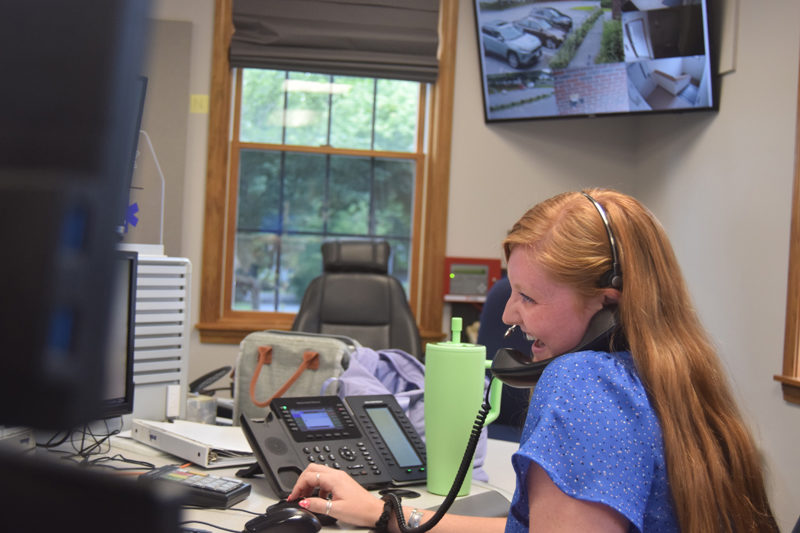
Rhiannon “Rhi” Hersey laughs at a joke told by fellow dispatcher Regan Pearce while on a nonemergency line on the phone at the Lincoln County Communications Center in Wiscasset on Thursday, July 25. Hersey, who is the most experienced of the three dispatchers on the shift, takes on the role of acting supervisor. (Nolan Wilkinson photo)
(Editor’s note: Earlier in July, readers had the opportunity to choose an industry for a reporter to write a day-in-the-life feature about. Emergency services emerged as the winner with 34.6% of votes cast.)
“Nine-one-one, what’s the address you’re calling from,” asks Regan Pearce, a dispatcher at the Lincoln County Communications Center in Wiscasset.
A red light illuminates the translucent plastic panels surrounding her workstation, signaling to the dimly lit room she is dealing with an emergency call. She wears a thin headset with one side a speaker and the other a microphone. Two more phones sit on either side of the desk in front of her. At any moment, she may have to answer another call while still dealing with this one.
Two other desks have dispatchers behind them today. One of them is busy with a nonemergency call. The other listens to Pearce’s call, ready to dispatch the needed services to the caller’s location.
A caller’s address, according to Pearce, is the first and most important thing to determine, because if the line is disconnected, she can still send someone to investigate.
“What number are you calling from,” Pearce then asks. She needs somewhere to call back should she need more information or a disconnect occurs. Then “What is your emergency?”
Pearce follows a series of protocols, semi-scripted questions and instructions designed to determine the nature of an emergency and get the info needed for responders to act quickly and effectively, while also managing the situation at hand.
If the caller says there has been a fall, which is among the most common reasons people dial 911, Pearce would ask when the fall happened, if any injuries occurred, how far of a fall it was, and if there is any bleeding.
Most of the time, she looks at one of five screens in front of her, where the computer offers responses from dispatch protocol. Pearce enters the information garnered in conversation, and the computer gives further instruction. If needed, Pearce can follow the same protocol from a physical binder.
For 911 calls, the dispatchers typically have a second person listen in. On Pearce’s calls, this is usually Rhiannon Hersey, who started at the communications center in March 2023. She is the most experienced of the three dispatchers usually working together in Pearce’s shifts and is the de facto supervisor.
If Pearce needs to remain on the call, Hersey can dispatch the needed emergency services to the situation.
The person who dispatches emergency services would typically keep track of the dispatched unit via radio. They acknowledge and repeat when emergency services depart, arrive, and leave the scene. They answer any questions a unit may have, and they can direct additional units to the scene, if needed.
Pearce also answers the nonemergency line, which mostly consist of requests for information the communications center keeps track of.
Pearce must keep track of every communication she has over the day as well. She records the time of a call, time of dispatch, details of a situation, and time the situation has been deemed clear.
Twenty-year-old Pearce is most often paired with 25-year-old Hersey, and 35-year-old trainee Trevor Whitney. They make up three of the 11 dispatchers at the communications center in Wiscasset. There must be at least two dispatchers ready to answer 24 hours a day, seven days a week.
Pearce was hired in late 2023 and had to take classes over five months to be counted as a full dispatcher. She said she was told in one of her first classes that most dispatchers burn out within three years.
Each day she sets her alarm for 3:30 a.m., with the expectation of making it to work from her home in Whitefield by 5 a.m. She does not leave the communications building until 5 p.m.
Dispatchers usually work three 12-hour days and a six-hour day in a week, which puts them at 42 hours a week.
“Sometimes we could have nothing to do for four hours, and then suddenly we could be unable to heat or drink for six hours and be totally slammed,” Pearce said. “It’s just the luck of the day.”
Pearce regularly juggles multiple calls, and she said one of the more difficult parts of the job is determining what takes priority.
“It’s weird to sort of say what one person is dealing with has to wait,” Pearce said. “I don’t know how I feel about that.”
Pearce and her fellow operators handle calls for all of Lincoln County as well Farmingdale, Gardiner, Pittston, Randolph, and West Gardiner in Kennebec County. The dispatch room is constantly filled with the sounds of calls and radio dialogue.
Tara Doe, director of the communications center, said mental health is a concern she takes seriously. She meets with dispatchers involved in particularly challenging or traumatic situations and tries to account for their health.
The dispatchers receive little closure on the numerous situations they are exposed to, despite having to talk to people whose houses are burning down or have had a stroke, Pearce said.
“They all come home with you,” Pearce said.
Lincoln County Emergency Management Agency Director Maury Prentiss often visits the dispatchers with photos from some of the calls they handled. Pearce said seeing the pictures is helpful in moving past many of the things she’s had to deal with, as they aren’t left up to her imagination anymore.
For more information about the Lincoln County Communications Center, go to lincolncountymaine.me/communications-9-1-1.






